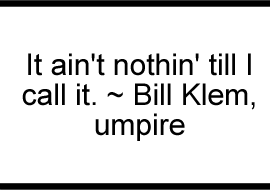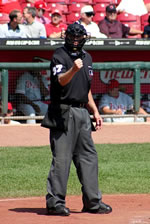Catchers: Tips, Drills, Information, Catching Equipment, Catchers Gear |
||||
Baseball-Catcher.com |
||||
Catcher Umpire Interaction |
||||
|
Basic Skills Stance Setting Up Receiving Framing Blocking Throwing Leadership In-depth Skills Relays, Cutoffs, and Plays at Home Signals Calling A Game Catching Bullpens Covering Bases Pre-Game Routine Umpire Rapport Misc. Situations and Plays |
Umpire - catcher interaction can best be described as a political dance. The object is to get the most from the umpire through the exchange of information in a manner that does not offend the ump. This interaction will help the catcher and pitcher determine the called strike zone. Your purpose is to get as many called strikes for your pitcher as possible.This area of catching knowledge and the techniques for talking to umpires develop over time.  The following information is an excerpt from "Catcher in the Raw" by Dennis Read. The article appears in the February 2000 issue of Coaching Management. Coaches interviewed for this article include: Mike Lane, Head Coach at the University of North Alabama, Ed Cheff, Head Coach at Lewis-Clark State College, and Mickey McMurtry, Head Coach at Lassiter High School in Marietta, Ga. Another notable aspect of the catcher's leadership role is interacting with umpires. "That's something you have to nurture and develop," [Mike] Lane says. "We tell our guys, 'You have to be a diplomat back there, you have to be a politician.' If an umpire misses a curve that was right there, and the catcher knows it's a strike and says, 'Blue, that was there, wasn't it?,' he's telling the umpire he thinks he missed the call. A lot of umpires don't take well to that. But if the catcher says to the umpire, 'Blue, was that a little low?,' then he's giving him an opportunity to say 'Yes,' or 'You know, I might have missed that one.' Then the catcher can say, 'That's OK, we'll get the next one.'"  |
 OnBaseball.com | ||